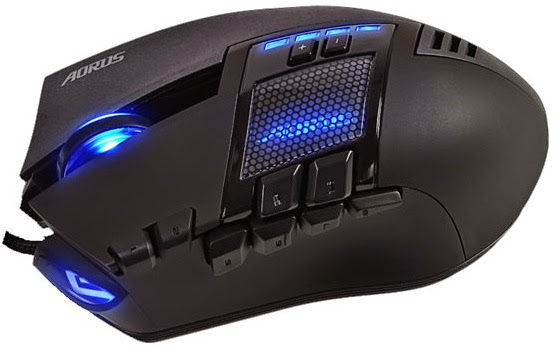There seems to be something of a glut of hardware manufacturers spinning off their gaming peripherals wings into separate, standalone brands. Thermaltake did it with its Tt eSPORTS department, Kingston is attempting to do it with its HyperX brand and now Gigabyte is getting in on the act with its Aorus brand.
The team behind the new name isn’t playing safe either, as the £70 M7 is a distinctive first release. Aimed squarely at the MMO crowd, it’s festooned with large buttons down its thumb-side edge, which has the unfortunate result of making it look a little ugly and unbalanced.
Another unusual styling choice is the pair of transparent panels built into the body of the M7. Peering through these panels reveals a plastic shroud shaped like a car engine, which covers the electronics inside the M7. However, this aesthetic feature comes across as tacky to the average hardware enthusiast, who would much rather see the electronics and switches that make the M7 tick.
We’re also dubious about the number of LEDs that the M7 sports. Call us grumpy old men, but having the scroll wheel, DPI gauge, base, internal logo (viewable through the transparent panels) and a pair of front LEDs illuminated seems a little much. Thankfully, most of these LEDs can be turned off in the tidy, if basic, software suite.
Still, beauty is in the eye of the beholder – as they say – and what really matters is how the M7 performs when the spells and charms are flying. In this regard, however, we can’t say impressions are much improved.
For a mouse with so many buttons, the M7 is slightly smaller than other MMO mice, meaning it feels rather cramped when you’re using it, especially when compared with the similarly button-heavy (but slightly larger) Razer Naga or Corsair M95. You certainly won’t like using the M7 if you favour a palm grip, as the short length of the body of the mouse makes this grip all but unusable.
The buttons aren’t particularly well placed either, as they’re all positioned above or forwards of the place where your thumb would normally reside. On the plus side, this keeps the buttons out of the way when you’re just using the mouse in Windows, but it also makes them tricky to reach in games. It feels like these buttons have been added simply to fulfil a feature checklist, rather than carefully placed in the appropriate positions.
Additionally, we found that we had to disable the single button on the other side of the M7 (which, by default, flicks between the five built-in profiles), as it was located precisely where your ring finger typically sits. As such, we often ended up pressing it accidentally when gripping the mouse tightly when gaming.
There are some positives to the M7 though - tracking proved smooth and accurate on a variety of common surfaces, and the thumb buttons have pleasant, distinct edges, meaning they’re easy to tell apart when you need them. These benefits really aren’t enough to rescue the M7, however, and for £70, we certainly expect better design.
The M7 has a brave design, but it doesn’t entirely work for its intended purpose. Whether or not you like the idiosyncratic styling is a subjective matter, of course, but the placement of buttons around the mouse leaves a lot to be desired for MMO gaming. Unless you have an LED fetish, the similarly priced and significantly more polished Razer Naga or Corsair M95 are better buys for MMO gaming.
SPECIFICATIONS:
Connection Wired, USB
Cable Braided
Material Plastic
Extras Carry case
